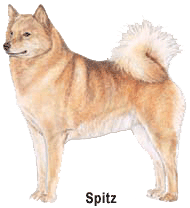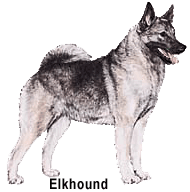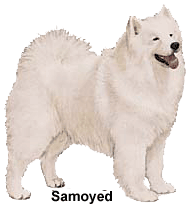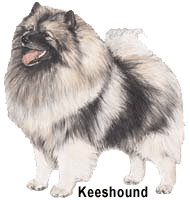The Pomeranian, or "Pom", is a small, sturdy toy dog that descended from the sled dogs of Iceland and Lapland. It stands about 6 in. (15.3 cm) high at the shoulders and weighs from 3 to 7 lb (1.4–3.2 kg). It has a double-coat consisting of a short, fluffy, under layer and an abundant, long, straight topcoat that forms a ruff of stand-off hair on the neck and back. It also has a fringe of feathery hair on the hindquarters. Poms come in many different colors, such as red, cream, black, brown, orange, sable, blue, white, and multi-color sometimes referred to as parti-color. The Pomeranian's coat gives the appearance of being difficult to care for, but it is actually quite easy to maintain, and with a regular brushing, will stay in good condition.
The immediate ancestor of the Pomeranian is a larger dog which was used in Europe for sheep herding. Queen Victoria was the first to bring a smaller specimen from Italy to England in the late 19th century, and they became very popular. The Pomeranian makes a magnificent family pet, and they are hearty and strong despite their fragile appearance. Pomeranians have become one of the most popular of the registered dog breeds in America, and their popularity continues to grow.
 The Pomeranian is related to the Spitz family, which are furry dogs from the blustery Arctic circle. They are renowned for their skills in carrying loads, hunting, and for their guard dog duties.
The Pomeranian is related to the Spitz family, which are furry dogs from the blustery Arctic circle. They are renowned for their skills in carrying loads, hunting, and for their guard dog duties.
The Pom got its name from a small province called Pomerania in what is now eastern Germany. Back in the Renaissance era, the early German Poms weighed about 35 pounds, but they were highly desirable pets for the people who lived in continental Europe at the time.
Michelangelo had a Pomeranian who patiently watched him paint the Sistine Chapel ceiling. Isaac Newton had a Pom named Diamond. Mozart had a female Pom named Pimperl (to whom he dedicated an aria) and Chopin was so amused by his girlfriend's Pom that he composed the "Valse des Petits Chiens" for the pet.
Continue
In 1761, 17-year-old Charlotte from a neighboring province of Pomerania traveled to England and married Prince George III. She was the first to bring Poms to England. They were mainly white dogs and most weighed over 20 pounds. The granddaughter of Queen Charlotte was Victoria and she was a devoted dog fancier. When her husband (Prince Albert) suddenly sickened and died in 1861 at the age of 42, the saddened Queen grew even fonder of her gentle pets. She raised more than 15 different breeds of canines in her lifetime, and in her later years, her attentions were particularly focused on the Pomeranian breed.
 The beloved Queen made a trip to Italy in 1888 and while there she purchased a sable red Pom named Marco and brought him back to England. Marco weighed only 12 pounds and today, many dog historians point to him as being the instigator of the desire to breed smaller Pomeranians. Marco went on to compete under the Queen's name in many dog shows and won many honors. Victoria also bought three other Poms on the same trip to Florence in 1888. The most famous next to Marco was a cute little female named Gina. She also became a champion at London dog shows.
The beloved Queen made a trip to Italy in 1888 and while there she purchased a sable red Pom named Marco and brought him back to England. Marco weighed only 12 pounds and today, many dog historians point to him as being the instigator of the desire to breed smaller Pomeranians. Marco went on to compete under the Queen's name in many dog shows and won many honors. Victoria also bought three other Poms on the same trip to Florence in 1888. The most famous next to Marco was a cute little female named Gina. She also became a champion at London dog shows.
Spurred by the Queen's kennel of Poms, English dog fanciers began breeding even smaller Poms, and when the adult dogs began to hit below eight pounds they were called Toy Pomeranians. In 1888 the first American Pom was entered into the American Kennel Club's stud book, and in 1892 the first Pom to be shown in America was entered in a dog show in New York. The Pom is a very lovable dog, is excellent with children and can be trained to do many tricks. A full-blooded toy Pomeranian pups can command hefty prices for their masters, but they have such desirable qualities that most owners consider it money well spent. The Pomeranian owes its genetic makeup to a diverse group of sledding, hunting, and herding dogs that sprang from northern Europe, commonly lumped together as the Spitz. Its relatives, the Samoyed, the Norwegian Elkhound, and a number of other breeds certainly have proven their worth as workers, companions, and pets.
The Pom is a very lovable dog, is excellent with children and can be trained to do many tricks. A full-blooded toy Pomeranian pups can command hefty prices for their masters, but they have such desirable qualities that most owners consider it money well spent. The Pomeranian owes its genetic makeup to a diverse group of sledding, hunting, and herding dogs that sprang from northern Europe, commonly lumped together as the Spitz. Its relatives, the Samoyed, the Norwegian Elkhound, and a number of other breeds certainly have proven their worth as workers, companions, and pets.
The Samoyed's look very much like the American Eskimo Dog. They are perky, dependable playmates, often wearing "smiles" on their faces. They are full of fun, and love nothing more than an afternoon of frisky activity in the snow. They are active and alert, indoors and out.
It takes a brave dog to track a moose, and that's what Norwegian Elkhounds did for thousands of years. Over the thousands of years it has existed, the Norwegian Elkhound has looked just as it does now. Nature made him strong and clever, so he could be a good hunter. His thick, soft, gray coat can stand the cold and snow of Norway. His noble, playful ways have made him a beloved friend.
The Keeshond (KAZE-hond), sometimes known by the unflattering name of "over-sized Pomeranian" is a happy dog by nature. They are extremely affectionate. When a Keeshond joins the family, he looks forward to being an important part of it. He loves children and will gladly play games and bounce around with them.
Information and drawings presented here came from the American Kennel Club (AKC) and other sources on the Internet.
